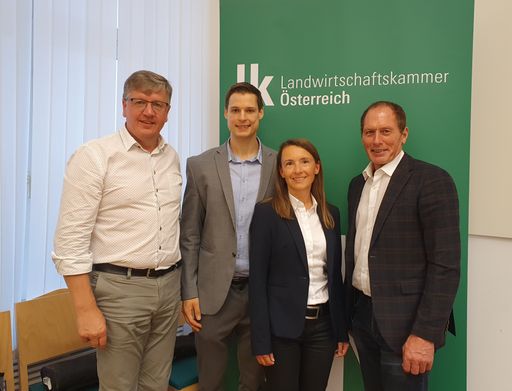“Our goal is not only to make an active contribution to the fight against climate change with biomass etc., but also to be able to offer farmers ‘tools’ to adapt to the changing conditions. To ensure the latter, we have “We launched the education offensive ‘Agriculture.Climate.Fit’,” emphasizes the President of the Austrian Chamber of Agriculture Josef Moosbrugger. “In close cooperation with various scientific institutions, 163 concrete recommendations for action in the areas of arable and grassland cultivation, cattle and pig farming were developed. These are now available in over 50 educational videos, four brochures, and the website https://www.klimafittelandwirtschaft.at/ and many other information materials are available free of charge,” reports Moosbrugger and also points to the YouTube channel https://www.youtube.com/@landwirtschaft-klima-fit hin.
Answering the growing flood of inquiries based on science
“The educational offensive ‘Agriculture.Climate.Fit’ is an indispensable basis for the future. The starting point was that, as the central contact point for farmers, we noticed a growing flood of questions about adapting to heat, drought, heavy rain, etc. Here we wanted to be scientific “We can offer well-founded and practical answers and also bundle existing information even better as part of the two climate fit projects of the Rural Training Institute (LFI) – one on crop production and one on animal husbandry,” reports the LKÖ President. “With the concrete results and recommendations for action in various channels, we give agricultural teachers and consultants just as valuable tools as farmers in practice themselves,” says Moosbrugger happily.
Extensive information materials and interactive climate tool
“Since 2021, we have been collecting inquiries from farmers about climate change adaptation and submitting them to scientific institutions such as the HBLFA Raumberg-Gumpenstein, the HBFLA Francisco-Josephinum Wieselburg, the University of Natural Resources and Life Sciences Vienna or the University of Veterinary Medicine Vienna. We then have all the answers “In the future, it will be combined with existing information material, clearly prepared and made available in various digital and analogue forms,” reports the head of the LFI project “Agriculture.Klima.Fit”, Florian Sitzwohl. In addition, an interactive climate tool for visualizing climate parameters today and in the future was created together with GeoSphere Austria (formerly ZAMG).
“Agriculture is one of the areas most affected by climate change. At the request of the LKÖ and LFI, we were happy to join the ‘Agriculture.Klima.Fit’ initiative in order to provide scientific answers to farmers’ pressing questions about the future and to incorporate them into education and advice “The topics of climate protection, climate change adaptation and climate impact research play a central role in the research work at the HBLFA Raumberg-Gumpenstein,” reports Elfriede Ofner-Schröckdeputy head of the Institute for Organic Agriculture and Livestock Biodiversity and head of department for species-appropriate animal husbandry, animal welfare and herd management at the HBLFA Raumberg-Gumpenstein.
How to avoid heat stress in cows
“For example, the questions were about how heat stress for cattle and pigs can be avoided or reduced as far as possible given the constantly changing temperature records. There are a number of options for this, both in new stables and in existing stables,” explains Ofner -Schröck. “When building a new building, it is advisable to align the stable according to the wind direction and to ensure a well-insulated or ventilated roof, i.e. a cold roof. But fans of the appropriate dimensions or water misting can also help to increase the well-being of the animals. This is very important An appropriate drinking water supply, optimal pasture management and good farm management can also be valuable,” says the scientist.
Keep water in the soil, avoid erosion, promote fertility
“Agriculture is primarily about the topic of soil. On the one hand, the questions revolve around how it can be possible to farm in the most water-saving way possible, but at the same time how to protect the topsoil from erosion during heavy rain events and improve the storage capacity of the soil. On the other hand “Promoting soil fertility itself is a ‘solution multiplier’ in which yield levels as well as biodiversity are improved,” reports Sitzwohl.
“It is advisable to optimize cultivation methods, for example through mulch or direct sowing, where the soil cover is only slightly cultivated. But the creation of landscape elements such as hedges and greenery can also help to prevent soil erosion and promote diverse soil life .Cultures or varieties adapted to the location and a diverse crop rotation can also serve well. For example, legumes in the crop rotation are good for loosening the soil and supplying it with nitrogen in a natural way “We are also better able to deal with longer periods of drought. But climate-friendly crops and varieties for which there are separate projects will also become increasingly important in the future,” emphasizes Sitzwohl. In the medium to long term, the possibility of irrigation will also have a significant impact on agriculture.
Together with LKÖ President Moosbrugger, he also thanks the Ministry of Agriculture, the above-mentioned research and educational institutions, the Austrian Agency for Health and Food Security (AGES), the Austrian Board of Trustees for Agricultural Technology and Land Development (ÖKL) and many other project partners for support and perfect cooperation .
